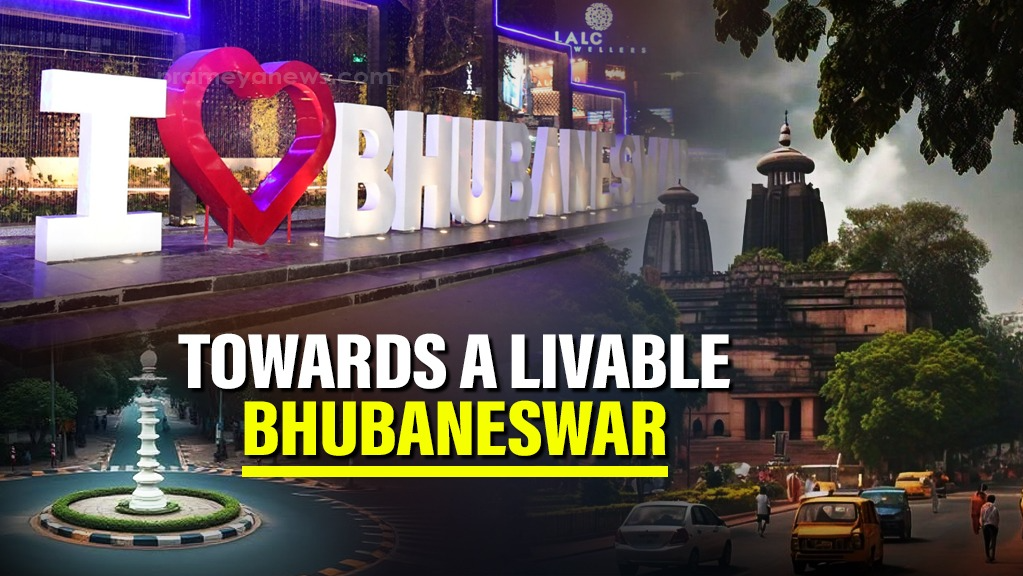

Konigsberger's Vision to unplanned Urban Sprawl: Bhubaneswar requires a new Blueprint
Bhubaneswar, a city born from a vision of meticulous planning, now finds itself at a critical juncture, grappling with the swift currents of urban expansion. Once a serene capital, its transformation into a bustling hub has brought forth challenges that test its original design, yet also illuminate pathways for improvement. The journey of Odisha's capital from a tranquil town to a rapidly growing city highlights a common urban narrative: the delicate balance between development and maintaining a high quality of life for its inhabitants. With thoughtful planning and a commitment to sustainable practices, Bhubaneswar has the inherent potential to evolve into an exemplary livable city.
The city's early design, conceived by German architect Otto Konigsberger in 1966 after Bhubaneswar replaced Cuttack as Odisha's capital in 1948, was tailored for a population of around 40,000. It featured a linear layout with government buildings, employee quarters, distinct neighborhoods, and markets, all interconnected by wide, parallel roads and grid networks. Circular squares served as crucial traffic nodes. In this era, bicycles were the predominant mode of transport, and lush greenery was an integral part of the cityscape. However, the Bhubaneswar of today has expanded far beyond this initial template. From a population of 885,363 in the 2011 census, it is now projected to house around 1.3 million people, marking it as one of India's fastest-expanding urban centers. This rapid demographic and infrastructural growth, while indicative of progress, has led to significant urban pressures. For instance, areas like Khandagiri, once on the city's outskirts, are now burgeoning urban landscapes, and travel times to the city center have dramatically increased due to traffic congestion. Urban planner Piyush Ranjan Rout has cautioned that this unbalanced and unplanned growth could lead to severe commuting challenges if not managed effectively.
The city's road network, managed by multiple agencies including the state's works department, the Bhubaneswar Municipal Corporation (BMC), and the National Highway Authority of India, is extensive. However, the number of registered vehicles has seen an exponential rise, from about 25,543 in 2000-01 to 110,370 in 2019-20, with two-wheelers constituting approximately 80 percent of the total. This surge has placed immense strain on the existing infrastructure.
Amidst these challenges, Bhubaneswar has demonstrated notable success in public transportation. The launch of the "Mo Bus" service (now Ama Bus) in 2018, under the Capital Region Urban Transport (CRUT), marked a significant turning point. Before its introduction, buses accounted for a mere 8 percent of all trips. A 2023 CRUT report revealed a 200 percent increase in Ama Bus ridership over four and a half years, with 57 percent of commuters shifting from private vehicles. This initiative, complemented by the "Mo E Ride" electric three-wheeler feeder service, has earned national recognition, with Bhubaneswar receiving the "City with Best Public Transport System" award from the Union Ministry of Housing and Urban Affairs in October of the previous year.
Despite these strides, several "pressure points" persist. Key arterial roads like the Jayadev Vihar-Nandankanan stretch, Khandagiri to Tomando, and Pahala to Rasulgarh experience severe traffic jams during peak hours. This congestion is largely attributed to the concentration of new commercial establishments, IT parks, corporate hospitals, educational institutions, and large residential complexes along these corridors. Even in the older, well-planned areas, increased vehicular density has led to parking woes, with roadsides often clogged with parked vehicles due to insufficient dedicated parking and encroachment on pedestrian pavements by commercial outlets.
This traffic snarl directly contributes to escalating pollution levels. A 2023 study highlighted that transport emissions are a major source of nitrogen oxides (NOx), with significant concentrations in relatively small areas. Road dust and vehicular emissions are also primary contributors to PM10 and PM2.5 particulate matter, with Bhubaneswar's annual average PM2.5 concentration often exceeding national standards, particularly during winter. The rapid pace of construction, while indicative of development, also generates substantial dust pollution and often comes at the cost of the city's green cover. Reports indicate a concerning trend of razing green government and MLA quarters for multi-storey constructions, further diminishing the city's capacity to absorb pollution. This environmental degradation has tangible health consequences, with a reported 30 percent increase in respiratory problems over the past five years, especially affecting children and the elderly.
Recognizing these pressing issues, efforts are underway to mitigate the problems. Parallel roads are being constructed to alleviate congestion on high-traffic routes, and underpasses have been created, with plans for more flyovers. Odisha's Transport Commissioner, Amitabh Thakur, mentioned that the government is collaborating with IITs for improved road and traffic management strategies, including proposals for AI-monitored traffic signals.
A fundamental issue, however, lies in the original road design philosophy, which primarily catered to cars and heavy vehicles, despite the overwhelming majority of commuters using two-wheelers and bicycles. The lack of dedicated corridors for these more vulnerable road users poses safety risks and discourages sustainable transport options. The "Mo Cycle-Public Bicycle Sharing" project, launched with much fanfare in 2018, unfortunately, lost momentum after a few years.
The path forward for Bhubaneswar hinges on a multi-pronged approach. Revitalizing and expanding initiatives like the Mo Cycle project with dedicated, safe bicycle lanes is crucial. Clearing and reclaiming pavements for pedestrians, coupled with a significant effort to increase green cover throughout the city, will not only enhance aesthetics but also play a vital role in pollution mitigation and improving public health. Bhubaneswar's journey as a "Smart City" requires a renewed focus on smart, sustainable urban planning that prioritizes the well-being of its citizens and the environment. With strategic interventions and a collective will, Odisha's capital can indeed transform its growth into an opportunity to create a truly livable, vibrant, and green urban future.